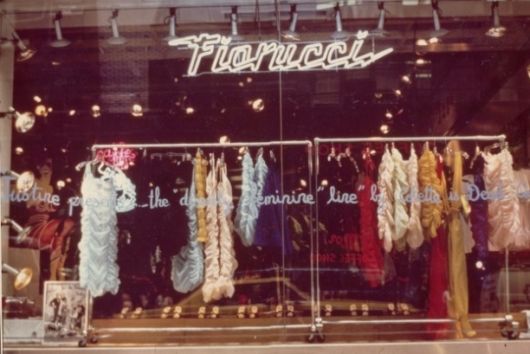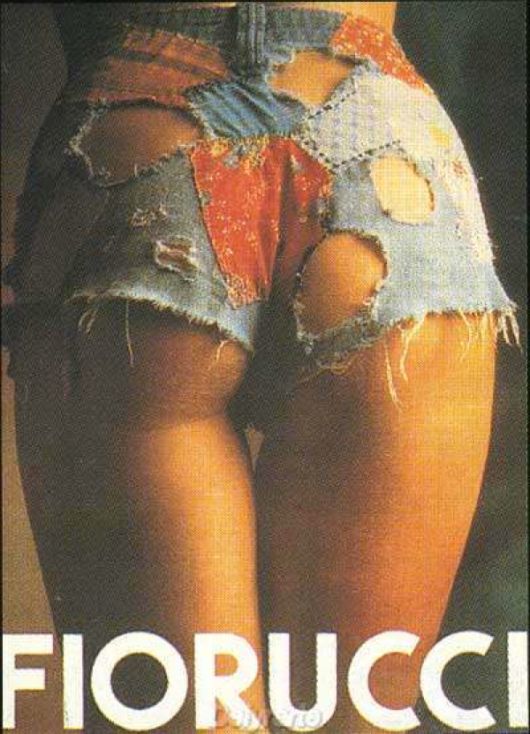
Science Is Over
by HELEN SCHUMACHER
At the dawn of the 1980s, no one’s wardrobe was complete without a pair of Fiorucci jeans. Preferably you would have seven of the skin-tight pairs — one in every color of the rainbow, to be worn with your gold Fiorucci cowboy boots. When he turned 15, Marc Jacobs "saved and saved" for his first pair. Miuccia Prada has claimed to have only ever owned one pair of jeans; they were from Fiorucci. Diana Ross, Jackie Onassis, and Lauren Bacall were fans, as was every 13-year-old girl with a Seventeen magazine subscription.
Elio Fiorucci opened his first shop in Milan in 1967 not with couture in mind, but with the idea of bringing the London street trends of the Youthquake movement to Italy. The Fiorucci line debuted shortly after in 1970. However, Elio was a marketing whiz with a taste for the outré, not a designer. The clothing reflected this; much of the line consisted of basics like polo shirts, denim jackets, and tote bags emblazoned with Fiorucci’s winged putti logo.

To Elio’s credit, before Fiorucci, designer denim was unheard of. The company was also one of the first to embrace a global aesthetic, importing not just English looks, but also drawing inspiration from traditional prints and fashions of India and Brazil, with Fiorucci sending young trendspotters around the world (or downtown) to scout for unique local styles to be reproduced by the label. "What he had done was to capture a kind of international ideal of teenage promise and bottle it," said Eve Babitz, author of Fiorucci: The Book.
While the garish fashions of Fiorucci may have rarely made the pages of Women’s Wear Daily, the stores’ parties did. The opening of the Beverly Hills store was famously shut down by the Los Angeles fire department. A year later, Blondie held a post-concert party in the same store to celebrate their album Parallel Lines going platinum. Attendees Wilt Chamberlain, James Woods, and Karen Black watched as Debbie Harry arrived in a World War II tank. Today one can revisit the scene by watching Xanadu, which features Olivia Newton-John and Michael Beck dancing to ELO’s "All Over the World" while Gene Kelly shops for a new suit.

The fluorescence of the Beverly Hills shop may have been permanently archived on celluloid, but the real epicenter of Fiorucci’s cool was its New York store at 125 East 59th Street. Opening in the spring of 1976, it soon became a destination for all those young and weird. The press compared its atmosphere of debauchery to that of Studio 54. In 1977, New York magazine would declare: "All it took this year to achieve instant chic, day or night, at the slickest New York party or the trashiest was a pair of $110 gold cowboy boots from Fiorucci."
Much of the store’s cachet was due to its eccentric staff. Klaus Nomi, drag performer Joey Arias, designer and filmmaker Maripol, and Madonna’s brother Christopher Ciccone all worked for Fiorucci during its heyday. The store was one of the first places to sell Betsey Johnson’s clothing and exhibit Keith Haring’s artwork. Fiorucci’s knack for youth-driven pop-art consumerism also attracted the likes of Andy Warhol. Surrounded by a coterie that included Truman Capote, Warhol launched Interview magazine with an in-store party. Douglas Coupland was inspired to quit studying physics after visiting the store.

"There was this absolute density of color and imagery," Coupland recalled. "I just thought it was the most perfect place I had ever been to." He brought back a postcard (the only thing he could afford). “It was on my desk. I looked at it and thought, 'Science is over.' I stopped caring about school. I had been a straight-A student and I started getting D’s. It felt like the best drug ever, and I thought, 'If this is what a bad grade feels like, this is great!'"
The store was a playground of glitter and spandex. Wide-eyed squares in their drab trench coats regularly gathered in front of the legendary window displays to see fashion at its most fun and subversive. It was Shangri-la for freaks and the conservative world couldn’t get enough. A People article from 1981 describes one memorable display: “Wearing a Merry Widow corset, bikini bottoms, fishnet stockings, and spiked heels, the Barbie Doll model reclined in a zebra-striped bathtub that had been placed in the window of Fiorucci's Manhattan store. For the next six hours she read smutty paperbacks, ate bananas, and blew bubbles — to the delight of a street crowd pressing 20 deep against the window.”

By way of explaining Fiorucci’s aesthetic, the article quotes Elio as calling haute couture “pathetic.” He embraced a certain trashiness in dress — lamé, peek-a-boo plastic, animal prints — literally incarnated when the store gave away miniature garbage-pail backpacks covered in brand-name stickers to customers who spent over $150.
Despite its popularity, the New York store wasn’t necessarily profitable. In the beginning, Fiorucci bet on the store’s ability to establish the brand’s image within the United States and, in turn, entice retailers around the country to sell Fiorucci merchandise, increasing the company’s wholesale business. At first the gamble paid off, and profits quadrupled the year following the store’s opening.

However, the label was built around the fickle tastes of the youth market and success was short-lived. Soon after Fiorucci jeans hit the market, Calvin Klein signed a jeanswear deal and his brand would emerge as the new must-have designer denim, bringing along with it his beige-on-beige minimalism as the look du jour. The Manhattan Fiorucci shuttered in 1988. The brand was further hindered by a series of ineffective business deals and relaunches that flopped.
Today a Williams-Sonoma occupies the 59th Street address and the Fiorucci name doesn't hold the same prestige it once did, but its impact remains. The boy who once spent his summers hanging out in the store, Marc Jacobs, has said his Marc line is influenced by the label. And the cheap plastic key chains and makeup compacts of his accessories boutique are certainly a nod to the tourist-friendly knickknacks Fiorucci used to carry. Any store that has hired a DJ and tried to turn retail into a party experience (ahem, Fashion’s Night Out) is indebted to the Italian label, as is anyone who has tried bring a little sex and trash into fashion.
Helen Schumacher is the senior contributor to This Recording. She is a writer living in Brooklyn. You can find an archive of her writing on This Recording here. She tumbls here and here. She last wrote in these pages about Device 6.

The Best of Helen Schumacher on This Recording Is Yours
Her time at recess & LHOTP
Which of the following images do you think represents this game?
The career of June Mathis
It was all a means of divination
Falling victim to the gory seductions of Clouzot
The life and death of Veronica Geng
Joy Williams oozes a milky substance

"The Key" - Hercules & Love Affair ft. Rouge Mary (mp3)
"I Try To Talk To You" - Hercules & Love Affair ft. John Grant (mp3)
